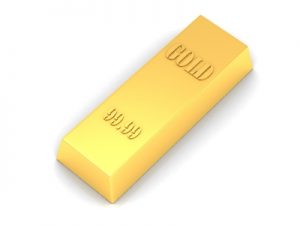Yesterday, Gold fell by $49 an ounce.
From the Financial Times:
Gold has tumbled to its lowest level in nearly three years, putting it on track for its biggest quarterly fall since the collapse in 1971 of the Bretton Woods system of exchange rates, which pegged the value of the dollar to the metal.
This is good news. Gold is doing what it should do. And it is giving us another good opportunity to buy a life vest before the boat sinks.

No market goes up without a correction. Speculators typically get ahead of themselves. They need to be slapped around a bit… tested… and tempered. Like a steel blade, they need to be hammered before they are ready for the final battle.
In the last major bull market in gold – which lasted for most of the 1970s – the gold price rose from about $40 an ounce to over $800 an ounce.
This was one of the greatest bull markets of all time. But it wasn’t without its challenges. The price of gold moved up fast. It needed to be knocked down at least once before it finally reached its top. Gold fell by 47% before rising eight times to its peak in 1980.
Let’s see. Gold began its current secular bull market at a bit under $300 an ounce. It rose to $1,900 an ounce. That’s a gain of $1,600 an ounce. If gold were to lose half its gains, it would have to fall by -$800… or down to around $1,100. So, we’ve still got a way to go.
Gold the Ultimate Money
But how do we know that the underlying causes of gold’s march to glory are still in place? We can never be sure. For thousands of years, gold has not been the only kind of money… but it has been the best kind. While other forms of money have failed, gold is still in business.
It is the ultimate money.
Some wealth is held in the form of tangible things. Other wealth is represented by paper – bonds, notes, bills, stocks, IOUs, etc. When an economy is growing it becomes more sophisticated… with relatively more wealth in paper form.
These are claims on other kinds of wealth, elaborated in a period of prosperity and trust. The more faith people have in “the system,” the more faith they have that their pieces of paper can be exchanged, some time in the future, for real goods and services.
When trust in the system slips, so too does faith in pieces of paper. Money holders begin to wonder about counterparty risk. Can the issuers of debt instruments really pay? Are corporations really as profitable as they say? Is the fellow who left us this IOU solvent?
When trust suddenly disappears, we get what is called a “panic.” This soon manifests itself as a “crash” in asset (paper) prices. Often, tangible assets go down too – such as real estate, art, and commodities.
That was the world, more or less, of the 2008-09 crash. When investors realized that subprime mortgage holders couldn’t service their loans, they began to wonder who else couldn’t pay. Surely, the banks that held billions of dollars of subprime paper would be in trouble too. And so would the homebuilders. And so would many others.
FED Head- Burns Returns?
Usually, the value of a particular kind of paper goes up during a panic. Bills of immediate maturity – cash – tend to become more valuable. It’s the thing that most people don’t have, and the thing they most need, to pay their bills.
Even gold can go down against cash. It’s cash people need, not gold.
But sometimes people’s trust in cash goes down too. That’s when you get a real panic. That’s what happened in the 1970s. Cash was losing value, thanks largely to over-spending by the government and an excessively long period of negative real interest rates from the Fed.
Believing, like his successor Ben Bernanke, that there is a trade-off between inflation and employment levels, Arthur Burns lent too low for too long.
Again, during the Alan Greenspan era, the Fed lent too much at too low rates for too long.
Ben Bernanke misread the signs completely. He called it the era of “Great Moderation.” But the stability he saw was a mirage. EZ money was like a liquor store that made home deliveries. It kept the problems from appearing in public. Debtors found it almost impossible to sober up. No matter how they mismanaged their affairs, someone would lend them more money.
The gold market realized that trouble was afoot. Investors kept bidding up the price of gold until, once again, they got ahead of themselves.
Now, gold is correcting…
But have the problems that gave rise to the bull market in gold been fixed? Has the level of debt been substantially reduced? Have dead-head institutions been cleaned out and cleaned up? Has the economy that got used to running on EZ credit shaken off the habit?
Is QE really coming to an end?
Probably not.
More to come…
Regards,
Bill
This article originally appeared in Bill Bonner’s Diary of a Rogue Economist and is reprinted by permission.
See Also:
- Economic & Fed Confusion Reign In Markets
- The Japanese Monetary Crisis
- Life in Argentina
- What is Basel III and Will it Help Avert Another Banking Crisis?
- The Greatest Wealth Transfer in History
 |
 |
 |
 |
| Gold: The Once and Future Money |
Rich Dad’s Advisors: Guide to Investing In Gold and Silver |
The True Gold Standard – A Monetary Reform Plan without Official Reserve Currencies |
The Case for Gold |
Photo Credits: “Gold Bar” courtesy of Boykung / FreeDigitalPhotos.net

